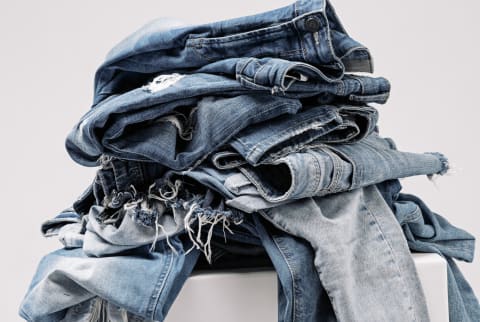Advertisement
So, What Actually Happens To Clothes When You Donate Them?


During a recent peek through my neighborhood farmers market, I spotted a pile of used clothing up for donation next to the compost collection station. "Pile" is an understatement. The collection of trash bags was more of a volcano, erupting with every color and style of garment you could imagine.
The sight might have once comforted me (hey, at least these were going to be resold and not sent to the landfill!), but since talking with journalist and fashion industry waste expert Elizabeth L. Cline, my view on the used-clothing industry has totally changed.
1.7 billion garments are exported out of the United States every year.
I first came across Cline's work during a Fashion Revolution Week event where she introduced her research on the secondhand clothing market. Turns out, the U.S. is the biggest exporter of used clothing in the world, and many of our pieces—billions of them a year—are sent to other countries to be resold or dumped in a landfill.
Eager to learn more from Cline, whose new book, The Conscious Closet: The Revolutionary Guide to Looking Good While Doing Good, hits shelves later this summer, I called her up to ask about the inefficiencies in the used-clothing market and how people can extend the life cycle of their garments. Here's what you should know:
EL: Why are so many of our clothes shipped off to other countries?
EC: It's not an easy answer. The first part of it is the fact that we live in a fast-fashion society. There are so many clothes produced and consumed in the so-called rich world countries every year. There is such a glut of unwanted clothes in the United States that the market really doesn't exist here to absorb all of them. Not to mention, we are constantly being advertised to buy new, and the message that it's important to buy secondhand isn't reaching enough consumers.
On the flip side, there is a big demand for used clothes in other parts of the world. Going back to the '70s and '80s, the so-called developing world has become a bigger and bigger market for the clothes that we no longer want. And so over time that's become the pattern: Whatever used clothing doesn't get sold by charities here is shipped to other countries. It's too complicated to say this is good or bad—but it's something that people who donate and get rid of clothes should be mindful of.
Have you come across any data on how many clothes that are donated in the U.S. end up overseas?
In the industry, the breakdown is usually presented as only 15% of all textile waste gets donated. I think we actually don't know how much clothing is flowing through charities and vintage shops. It's a very unregulated industry, and it's not very centralized.
But I can tell you that the equivalent of 1.7 billion garments are exported out of the United States every year. Some of that will go to recyclers to be shredded and turned into other products, but most of it will be sold as clothing. The other statistic that is important here is that on average, most resale stores and thrift shops only sell 20 to 25% of the donations they receive, and the rest is sent onward to exporters or recyclers.
I know you've done work in African countries that accept a lot of our used clothes. What systems do they have in place to process all of it?
There isn't a lot of really granular research on secondhand-clothing markets in the developing world, specifically in African countries because it's part of the informal sector of the economy. Not many people are actually going and talking to the secondhand traders there about what life is like for them and how what we donate affects their trade, livelihoods, and culture.
More clothes means more jobs, but it also means worse jobs.
With that being said, the OR Foundation has done granular research on Ghana's secondhand-clothing industry. And I've been to Nairobi to dig into the question of how an increase in the volume of used clothing affects the whole trade globally. I found that the higher quantity of clothes that goes into the system, and the lower quality they are, the harder it gets for anyone to make money as a used-clothing dealer.
More clothes means more jobs, but it also means worse jobs. Over time it just becomes harder to make a decent living. The other piece of it, and this is something that the OR Foundation discovered, is that a lot of the clothes we're exporting overseas just end up going to landfills in other places. A lot of stuff that we send overseas is stained; it's out of date; it's ugly; it should have never been made in the first place. There's way too much of it, and there's not going to be a buyer for every piece of clothing out there. So then you have countries that don't have a big budget to landfill things having to pay to landfill our garbage.
It sounds like low-quality items really have no place in the secondhand industry. What are your tips for people who want to stop playing into this problem?
The first thing to know is that for used clothing to have any sort of value, it has to be clean and well cared for. Make sure that everything is laundered and you've taken all your coins and tissue paper and tampons and receipts out. Get your clothes ready and looking good for the next phase of life. If you own anything that's valuable and on-trend, in good condition, I encourage you to sell or swap it because you spent money on your wardrobe and you should get that money back! You can reinvest it in your conscious closet.
As for what to do with your worn-out items, it depends on the resources you have locally. To find out, first call your local charity to see if they accept worn-out items. A lot of charities do, but it just depends on where you live. You can also look for an in-store take-back program like the ones at H&M, The North Face, and Levi's. Almost without exception, those bins accept both high-quality and worn-out clothing for recycling. Or you can see if you have any clothing bins around town and look up their acceptance policies online.
If you really don't have any textile recycling options locally, you might be able to keep scraps around for sewing and mending projects, contact a school to see if they're collecting scraps for crafting projects, or ask your local animal shelter if they're accepting scraps for dog toys and insulation. Just get creative and ask around.
Last but not least, remember that reducing clothing waste starts from the second you're in a store buying clothes. Don't buy too much, and take good care of the clothes you do have.
What about more difficult-to-get-rid-of items, like underwear?
Those go into the recycling category. "Worn-out items" extends to intimates or anything that you think wouldn't have a market. But underwear and bras actually have a surprising secondhand market too!
Is the textile-recycling industry facing the same problems as the secondhand-clothing industry?
Well it's important to point out that "recycling" means taking a product, breaking it down, and turning it back into another product. That's not really what's happening right now. It's mostly downcycling: It's clothing that's shredded for insulation or carpet padding or industrial wiping rags. True textile-to-textile recycling doesn't really exist at scale right now. Only 1% of clothing sold in the world is turned back into clothing.
I think that's important for shoppers and citizens to know—that we don't have a magic-bullet solution. The problems with the plastic recycling market should serve as a warning: We can't just consume as much as we want and see recycling as this perfect solution.
Here are some recycling and resale resources that Cline thinks are doing good work:
Eileen Fisher's Renew Program: They're setting an example for the fashion industry. They operate a full take-back program for their products and run their own resale program. That is true circularity.
Patagonia's Worn Wear Program: They're doing a good job repairing and reselling their products too.
Online Resale Platforms: ThredUP and The RealReal are destigmatizing wearing secondhand clothes and making it much easier for people to find and buy used garments, which reduces the demand for new products.
This interview has been edited and condensed.
Watch Next
Enjoy some of our favorite clips from classes
Enjoy some of our favorite clips from classes
What Is Meditation?
Mindfulness/Spirituality | Light Watkins
Box Breathing
Mindfulness/Spirituality | Gwen Dittmar
What Breathwork Can Address
Mindfulness/Spirituality | Gwen Dittmar
The 8 Limbs of Yoga - What is Asana?
Yoga | Caley Alyssa
Two Standing Postures to Open Up Tight Hips
Yoga | Caley Alyssa
How Plants Can Optimize Athletic Performance
Nutrition | Rich Roll
What to Eat Before a Workout
Nutrition | Rich Roll
How Ayurveda Helps Us Navigate Modern Life
Nutrition | Sahara Rose
Messages About Love & Relationships
Love & Relationships | Esther Perel
Love Languages
Love & Relationships | Esther Perel











